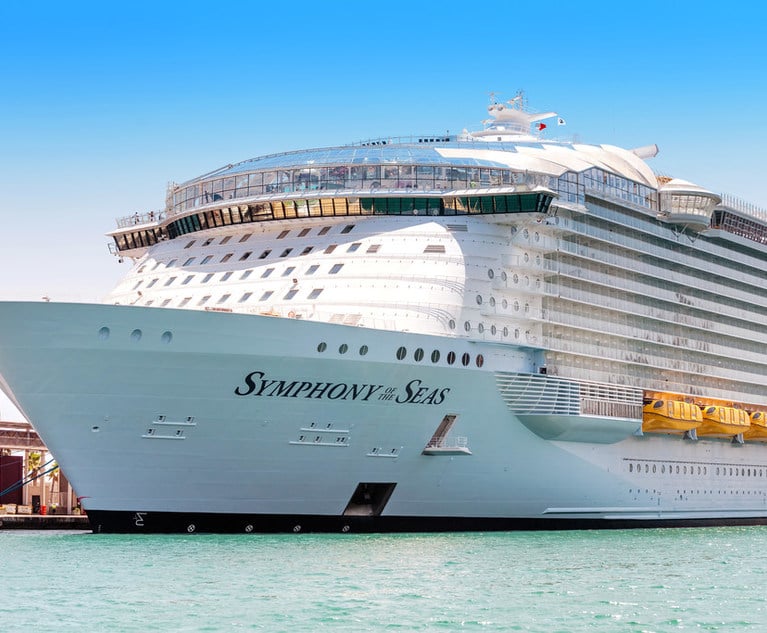Miami Attorney Helps Secure $3.3M for Man Whose Arm Was Amputated After Seeking Care for Flu-Like Symptoms
Thomas B. Scolaro, partner at Miami-based firm Leesfield Scolaro, represented Ilija Loncar in his suit against Norwegian Cruise Line. Loncar, a former employee of the cruise line, had his arm amputated by an on-board doctor in March 2016 after being erroneously treated for nausea with a promethazine injection.
September 10, 2018 at 02:03 PM
7 minute read
 Thomas Scolaro, partner with Leesfield Scolaro.
Thomas Scolaro, partner with Leesfield Scolaro.
While working as an employee of Norwegian Cruise Line, Ilija Loncar relied on his right arm to perform his job. As a waiter, Loncar was responsible for carrying trays and dishes to and from patrons as well as ensuring the general cleanliness of the Breakaway, the ship on which he worked.
But on March 28, 2016, Loncar lost his arm at the hands of a fellow Norwegian Cruise Line employee.
Loncar admitted himself to the Breakaway's infirmary for relief of nausea and flu-like symptoms. He instead left with a much larger problem: His entire right arm required amputation after an on-board physician, Dr. Sebastian Campuzano, prescribed him promethazine, an antihistamine, which the plaintiff claimed was injected in a massive dose over a small window of time, causing an intense and harmful reaction.
On June 13, Loncar received a $3.34 million arbitration award for past and present pain and suffering, loss of earning capacity and medical expenses. He was represented in his suit by Thomas B. Scolaro, a partner at Miami-based firm Leesfield Scolaro, and Mason Kyle Kerns of Mason Kerns Law in Miami.
Read Loncar's complaint against Norwegian Cruise Line here:
Scolaro did not mince words when discussing what befell his client. According to the personal injury lawyer, the doctor acted negligently on several counts.
Campuzano “gave the wrong medication, the wrong dosage by the wrong route through the wrong injection site, and it was administered over the wrong time and by the wrong method,” Scolaro said.
Scolaro added that an administration of promethazine intravenously was an overreaction to his client's complaints of nausea and Campuzano instead ought to have given Loncar the an anti-nausea medication Zofran. Scolaro maintains that drug would have been a more reasonable way to address Loncar's discomfort.
Furthermore, the 25-milligram dosage of promethazine far exceeded the generally accepted dosage for treatment, plaintiffs counsel argued.
“All the medical data out there strongly suggests six and a quarter milligrams is a perfectly therapeutic dose,” Scolaro said. “Campuzano orders it by intravenous injection when there is a pill, there's a suppository, there's a syrup. … He orders it by IV injection into the vein when — if you are going to order this medication through the injectable method — there's a FDA black box warning on IV promethazine, which says the preferred route is deep intramuscular, which is a shot in the tush.”
But for reasons “still unknown” to Scolaro and his client, Campuzano ordered the promethazine to be injected intravenously. What's more, it was injected in 10 to 15 seconds instead of the generally recommended 10- to 15-minute window, the plaintiff argued.
Loncar reportedly began experiencing pain almost instantly.
“As soon as the medication went in he immediately reported burning,” Scolaro said.
At that point, the attorney said, Campuzano and his nurse ought to have altered their course of action, given the patient's negative reaction.
“All the warnings out there say when there is a reported burning, you stop,” Scolaro said. “You don't continue. You don't pass go. You don't collect your $200. You stop immediately.”
When Loncar awoke several hours later, his arm had grown red and his fingers had turned black and blue due to a lack of oxygen, according to court pleading. Campuzano and his staff opted to massage Loncar's arm and fingers over a near-24-hour period, rather than call for a medical evacuation.
Once the ship docked, Loncar was transported to a hospital. But it was too late. His right arm was amputated due to a case of acute compartment syndrome, a condition that arises from pressure buildup caused by internal bleeding and swelling of tissues.
'That's FDA-Approved'
Loncar's suit alleged negligence and maintained that even though he had been prescribed the wrong medication, his arm could still have been saved from amputation had his symptoms of a poor reaction been properly addressed.
“They gave [Loncar] the most dangerous type of medication they could give to treat this very simple, common problem that can be treated with a very light and easy medication — Zofran. It's all they needed to do,” Scolaro said. ”It's like taking a Howitzer to destroy something when all you need to do is take a little BB gun and it would do the same thing. The Howitzer will destroy everything in its path. It was overkill.”
Scolaro told the Daily Business Review that Norwegian Cruise Line's counsel deferred to the Food and Drug Administration in its defense of Campuzano's behavior.
“It was a very strange defense: There's nothing wrong with prescribing IV promethazine. It's an FDA-approved medication; there is nothing wrong with ordering 25 milligrams, that's FDA approved; there's nothing wrong with doing it intravenously — it's FDA approved; there's nothing wrong with administering it over the course of two minutes — that's FDA approved; and there's nothing wrong with administering it with a syringe — that's FDA approved,” Scolaro said.
NCL's attorney, Curtis Mase of Mase Mebane & Briggs, did not respond to requests for comment before press time.
“They tried to use the FDA warnings as its assent to the doctor's conduct in this case when it's the furthest from the truth,” Scolaro said. “It's pretty telling just how graphic the warning is that they give you. This is a black-box warning medication, the highest warning they can give. And for a doctor to deliberately ignore the warnings. … that's a bit much.”
The defense also argued that Loncar had what they called a “venous anomaly,” predisposing him to the adverse reaction he experienced with the IV promethazine. Scolaro described this defense as “something I've never heard of, our experts had never heard of, the treating doctors had never heard of, and even their own expert that they found from Cleveland, he says he's heard of it. There is no medical literature. Nothing.”
“So we essentially called that out as junk science. And I think our arbitrator likely found this … given how he dismissed this expert's causation,” Scolaro said, referring to the “venous anomaly” theory as a “last-ditch effort at a defense.”
Read the $3.34 million award here:
“It was not hemodynamically possible, and quite frankly we thought it was completely incredible,” Scolaro said.
In Scolaro's estimation, the most dramatic point of the case took place during the deposition of Dr. Carlos Gonzalez, Norwegian Cruise Line's chief medical officer.
“We got Dr. Gonzalez to admit under oath that his own doctor violated and breached the standard of care,” Scolaro said. “Once that occurred, then it was essentially a damage-control situation from that point on.”
Although the case ultimately resolved favorably for their client, Scolaro said that it was a hard-earned award.
“It was certainly aggressively fought,” he said.”But we think that the right result occurred and that justice actually prevailed in this case for a wonderful and deserving client.”
Case: Ilija Loncar v. NCL (Bahamas)
Case No.: 01-16-0004-3640
Description: Medical malpractice
Filing date: Oct. 17, 2016
Verdict date: June 13, 2018
Judge: Peter Abraham, International Centre for Dispute Resolution International Arbitration Tribunal
Plaintiffs attorneys: Thomas Scolaro and Mason Kerns, Leesfield Scolaro, Miami
Defense attorneys: Curtis Mase and Laurence Krutchik, Mase Tinelli, Miami
Verdict amount: $3.34 million
This content has been archived. It is available through our partners, LexisNexis® and Bloomberg Law.
To view this content, please continue to their sites.
Not a Lexis Subscriber?
Subscribe Now
Not a Bloomberg Law Subscriber?
Subscribe Now
NOT FOR REPRINT
© 2025 ALM Global, LLC, All Rights Reserved. Request academic re-use from www.copyright.com. All other uses, submit a request to [email protected]. For more information visit Asset & Logo Licensing.
You Might Like
View All

A Voyeur Videotaped Them Undressing. Should Cruise Ship Passengers Have to Arbitrate?
3 minute read
Fowler White Burnett Opens Jacksonville Office Focused on Transportation Practice
3 minute read
'A Fierce Battle of Expert Witnesses' Expected in Cybersecurity Spat
Trending Stories
Who Got The Work
J. Brugh Lower of Gibbons has entered an appearance for industrial equipment supplier Devco Corporation in a pending trademark infringement lawsuit. The suit, accusing the defendant of selling knock-off Graco products, was filed Dec. 18 in New Jersey District Court by Rivkin Radler on behalf of Graco Inc. and Graco Minnesota. The case, assigned to U.S. District Judge Zahid N. Quraishi, is 3:24-cv-11294, Graco Inc. et al v. Devco Corporation.
Who Got The Work
Rebecca Maller-Stein and Kent A. Yalowitz of Arnold & Porter Kaye Scholer have entered their appearances for Hanaco Venture Capital and its executives, Lior Prosor and David Frankel, in a pending securities lawsuit. The action, filed on Dec. 24 in New York Southern District Court by Zell, Aron & Co. on behalf of Goldeneye Advisors, accuses the defendants of negligently and fraudulently managing the plaintiff's $1 million investment. The case, assigned to U.S. District Judge Vernon S. Broderick, is 1:24-cv-09918, Goldeneye Advisors, LLC v. Hanaco Venture Capital, Ltd. et al.
Who Got The Work
Attorneys from A&O Shearman has stepped in as defense counsel for Toronto-Dominion Bank and other defendants in a pending securities class action. The suit, filed Dec. 11 in New York Southern District Court by Bleichmar Fonti & Auld, accuses the defendants of concealing the bank's 'pervasive' deficiencies in regards to its compliance with the Bank Secrecy Act and the quality of its anti-money laundering controls. The case, assigned to U.S. District Judge Arun Subramanian, is 1:24-cv-09445, Gonzalez v. The Toronto-Dominion Bank et al.
Who Got The Work
Crown Castle International, a Pennsylvania company providing shared communications infrastructure, has turned to Luke D. Wolf of Gordon Rees Scully Mansukhani to fend off a pending breach-of-contract lawsuit. The court action, filed Nov. 25 in Michigan Eastern District Court by Hooper Hathaway PC on behalf of The Town Residences LLC, accuses Crown Castle of failing to transfer approximately $30,000 in utility payments from T-Mobile in breach of a roof-top lease and assignment agreement. The case, assigned to U.S. District Judge Susan K. Declercq, is 2:24-cv-13131, The Town Residences LLC v. T-Mobile US, Inc. et al.
Who Got The Work
Wilfred P. Coronato and Daniel M. Schwartz of McCarter & English have stepped in as defense counsel to Electrolux Home Products Inc. in a pending product liability lawsuit. The court action, filed Nov. 26 in New York Eastern District Court by Poulos Lopiccolo PC and Nagel Rice LLP on behalf of David Stern, alleges that the defendant's refrigerators’ drawers and shelving repeatedly break and fall apart within months after purchase. The case, assigned to U.S. District Judge Joan M. Azrack, is 2:24-cv-08204, Stern v. Electrolux Home Products, Inc.
Featured Firms
Law Offices of Gary Martin Hays & Associates, P.C.
(470) 294-1674
Law Offices of Mark E. Salomone
(857) 444-6468
Smith & Hassler
(713) 739-1250






